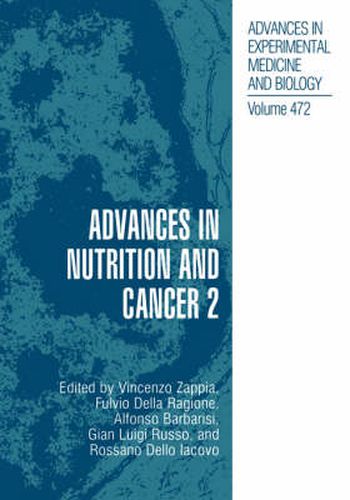Readings Newsletter
Become a Readings Member to make your shopping experience even easier.
Sign in or sign up for free!
You’re not far away from qualifying for FREE standard shipping within Australia
You’ve qualified for FREE standard shipping within Australia
The cart is loading…






This title is printed to order. This book may have been self-published. If so, we cannot guarantee the quality of the content. In the main most books will have gone through the editing process however some may not. We therefore suggest that you be aware of this before ordering this book. If in doubt check either the author or publisher’s details as we are unable to accept any returns unless they are faulty. Please contact us if you have any questions.
The advancements in the last six years derive from the extensive use of molecular approaches to perform research in the nutritional field. Moreover, the fundamental observation of R. Doll and R. Peto (1981), which suggested that at least 35% of all cancers (with large differences among different tumors) might be prevented by dietary regimens, has been confirmed by epidemiological studies. However, it is difficult to reduce them to simple terms - metabolic and hormonal factors, contaminants and biological agents, and deficiency of specific protective nutrients are all components of the same puzzle. In the 1990s a large number of compounds responsible for the biological activity of human foods have been identified and characterized. These molecules not only include important and well-known risk factors but, most promising, compounds, which might exert chemopreventive activity. Among them, antioxidants (such as vitamins, phenols, and lycopene) seem to play a critical role in reducing the risk of cancer at different anatomical sites, including colon, breast, and prostate malignancies. Other molecules, derived from fiber bacterial intestinal degradation (short fatty acids), are of interest, even if their importance has not been completely unravelled and is still the subject of debate. Data suggest that dietary-derived compounds, including radical scavengers, affect cell proliferation by acting on the cell division cycle engine and thus might control the process (and the rate) of malignant transformation.
$9.00 standard shipping within Australia
FREE standard shipping within Australia for orders over $100.00
Express & International shipping calculated at checkout
This title is printed to order. This book may have been self-published. If so, we cannot guarantee the quality of the content. In the main most books will have gone through the editing process however some may not. We therefore suggest that you be aware of this before ordering this book. If in doubt check either the author or publisher’s details as we are unable to accept any returns unless they are faulty. Please contact us if you have any questions.
The advancements in the last six years derive from the extensive use of molecular approaches to perform research in the nutritional field. Moreover, the fundamental observation of R. Doll and R. Peto (1981), which suggested that at least 35% of all cancers (with large differences among different tumors) might be prevented by dietary regimens, has been confirmed by epidemiological studies. However, it is difficult to reduce them to simple terms - metabolic and hormonal factors, contaminants and biological agents, and deficiency of specific protective nutrients are all components of the same puzzle. In the 1990s a large number of compounds responsible for the biological activity of human foods have been identified and characterized. These molecules not only include important and well-known risk factors but, most promising, compounds, which might exert chemopreventive activity. Among them, antioxidants (such as vitamins, phenols, and lycopene) seem to play a critical role in reducing the risk of cancer at different anatomical sites, including colon, breast, and prostate malignancies. Other molecules, derived from fiber bacterial intestinal degradation (short fatty acids), are of interest, even if their importance has not been completely unravelled and is still the subject of debate. Data suggest that dietary-derived compounds, including radical scavengers, affect cell proliferation by acting on the cell division cycle engine and thus might control the process (and the rate) of malignant transformation.